Raising sheep is a fun and rewarding way to add life to your homestead – as well as to expand your bottom line. Sheep don’t require a ton of pasture space, and are docile, good-natured animals for hobby farms.
Sheep can serve multiple purposes, including providing wool, meat, or even milk. Consider this guide to raising sheep if you are thinking about including sheep on your homestead or small farm.
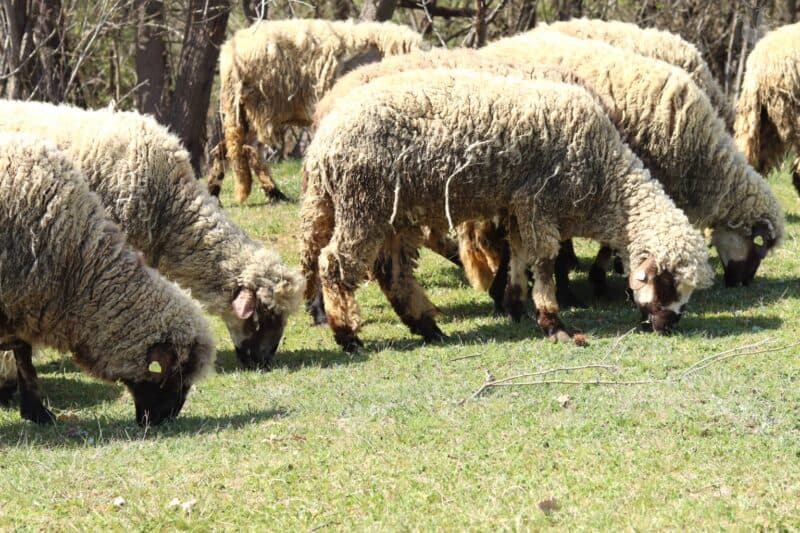
Table of Contents:
Why Should You Raise Sheep?
Sheep are one of the best livestock animals you can raise, especially compared to cows, pigs, or horses. They are relatively small and easy to handle, offering gentle temperaments and easygoing personalities.
Easy to train and work with, sheep don’t require a lot of special equipment, training, or natural livestock handling ability. They don’t need perfect pasture, as cows or horses might, and will instead eat weeds, brush, and junk grasses that grow everywhere -including in poor soil.
Sheep manure is a great fertilizer, and doesn’t need to be composted for quite as long as other types of manure (like chicken manure). It works quickly in the soil, meaning you can rotate your sheep pasture with crop planting locations, providing a wonderfully fertile soil for your future fruits and vegetables.
Best yet, sheep don’t require much space, with the space of less than an acre being enough to support a small flock.
Finally, sheep are multipurpose. While certain breeds are best adapted to certain purposes (like providing meat, milk, or wool) many can be raised as dual-purpose breeds, allowing you to get more bang for your buck and to raise an animal that will provide endless benefit for your homestead.
How to Select a Breed
When you are considering the best breed of sheep to raise on your homestead, the first question you need to ask yourself is what you plan to raise them for.
Do you want sheep for their wool or other fiber? For meat? Perhaps you simply want them to keep your lawn free of brush so that you can raise other more pasture-sensitive herbivores there later.
Whatever your purposes, there are several breeds of sheep that are commonly raised and, as a result, can easily be found in your local area for purchase or breeding. Interestingly, there are more breeds of sheep than any other livestock in the world except poultry.
In addition to deciding why you want to raise sheep, it’s important that you consider other genetic factors as well. These are often dependent on breed, but sometimes have more to do with how the flock was raised and what its parentage is like.
One factor you’ll want to consider is the mothering ability of your ewes – how well do the mothers care for their young, and how well do they birth them?
Do they allow them to suckle freely while nursing or are they more standoffish? Do they guard their young against aggressive rams and potential predators, or do they leave them to fend for themselves?
Another important factor in your decision-making process should be how well the flock fends for itself. Sheep aren’t known for being the farm animal with the most intelligence – yet they do have natural instincts that guide them towards good pasture and potential food sources.
Look for a breed of sheep that has naturally strong grazing tendencies. This can sometimes be learned by introducing good grazers to the flock, so don’t stress if you pick a flock that doesn’t have great natural grazing ability.
Sheep breeds are broken down into several general categories, including fine wool, long wool, medium wool, carpet wool, hair, fat-tailed, short-tailed, prolific, and primitive.
However, it’s easier to consider first what purpose you have in mind when raising sheep.
To do this, decide whether it’s more important for you to raise sheep for meat, fiber, dairy, or multiple purposes.
Meat Breeds
If you are in the market for a meat-only sheep, consider a Hampshire, Katahdin, or Suffolk sheep. Hampshires produce large flocks, with a high ratio of meat per sheep.
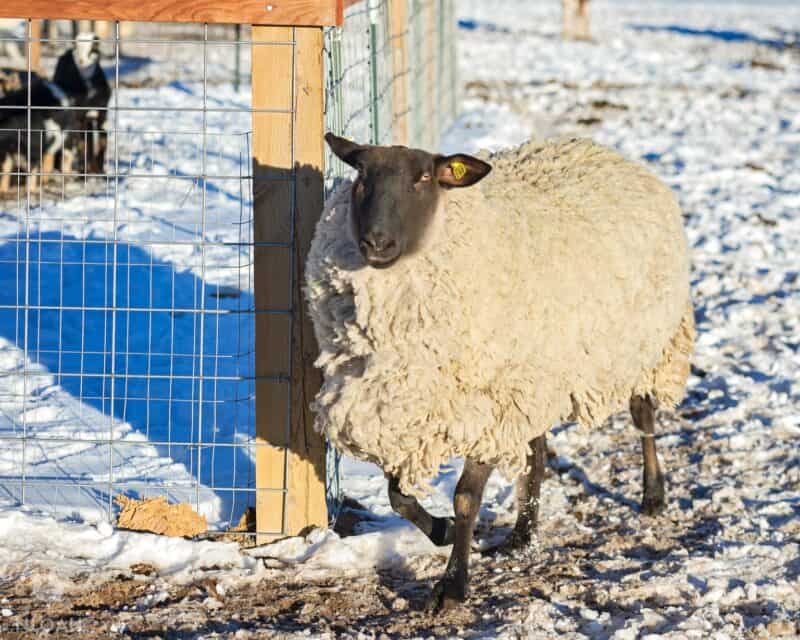
Katahdin sheep provide similar yields but are very low maintenance, while Suffolk sheep can be found just about anywhere in the continental United States.
Some other popular meat breeds include:
- Texel
- Southdown
- Border Leicester
- Corriedale
- Shetland
- Teeswater
- North Country Cheviot
- Wiltshire Horn
Fiber Breeds
As you likely already know, wool is quite the in-demand fabric, used for producing everything from tapestries to clothing to carpets and blankets. The wool from a flock of sheep of more than one sheep is known as a clip, while wool from a single sheep is referred to as a fleece.
Lambs produce less wool than ewes, and rams will produce more wool than ewes – it’s simply a matter of size. While every sheep will produce wool, each breed has various qualities that lend themselves to either high-quality wool or poor-quality wool.
Some breeds don’t produce fiber that is technically wool at all – they instead produce hair that they are able to shed, not unlike humans.
Here are some of the most popular fiber breeds you might find:
- Columbia
- Polypay
- Shetland
- Southdown
- Suffolk
- Targhee
- Navaja-Churro
- Black Welsh Mountain Sheep
- Herdwick
- Poll Dorset
- Merino
- Finnsheep
- Polwarth
- Teeswater
- Cotswold
- Leicster Longwool
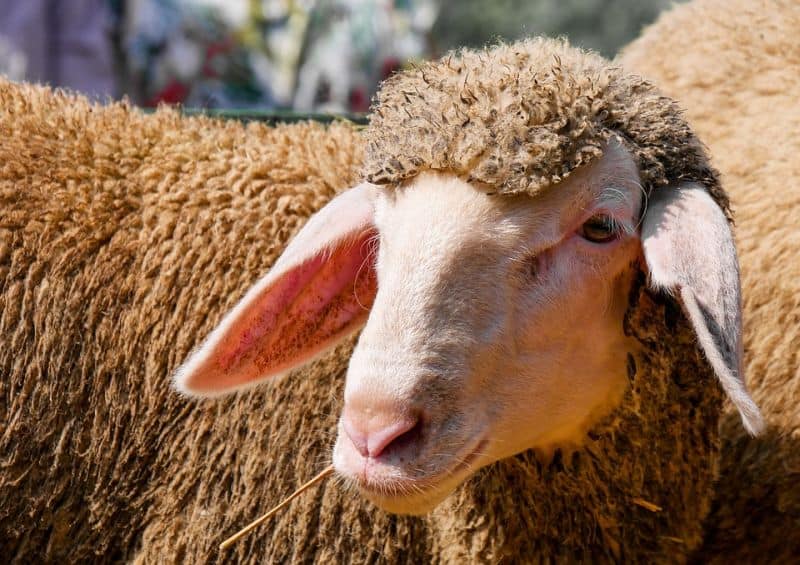
Dairy Breeds
Another factor to consider in your sheep purchase is whether you expect to get any milk out of the deal.
Sheep aren’t particularly well-known for their milk production, but some breeds, like Lacaune and East Friesian sheep, produce large amounts of milk and can be used for dairy and other dairy-related processes, like cheese making.
Technically, all sheep produce milk – as do all other mammals. However, not all sheep produce equally good milk. Ideally, you should look for a sheep breed that produces a yield per lactation of about 1000 to 1500 pounds of milk, as well as milk that is high in fat.
Interestingly, breeds that tend to produce twins or triplets at birth (rather than singles) also tend to produce more and better milk – something that is clearly connected to the need of the ewe to feed her young.
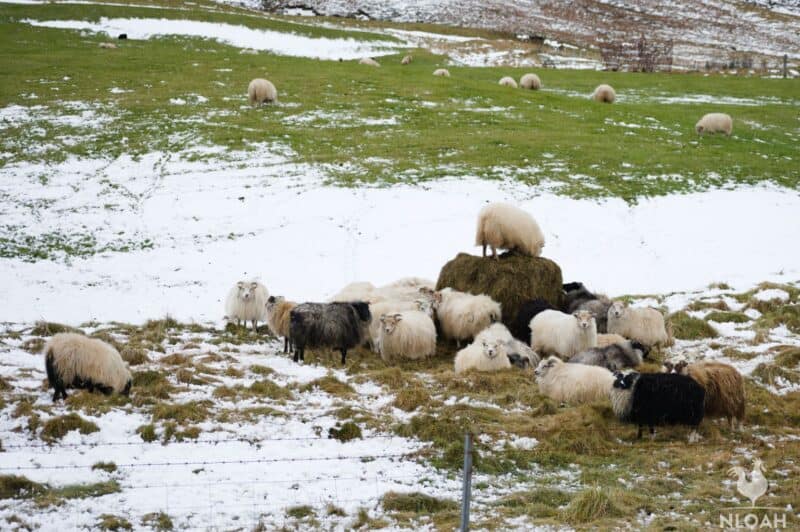
Some good breeds for dairy production include:
- Polypay
- Icelandic
- Dorset
- Finnish Landrace
Dual-Purpose Breeds
If you want a sheep that produces high-quality meat as well as plenty of wool, consider varieties like Dorsets, Corriedale, and Tunis sheep.
These all provide dense white wool and grow out quickly, meaning you can keep some for meat and raise the rest for wool in the meantime.
Here are some other popular dual-purpose sheep breeds:
- Merino (meat and wool)
- Leicester (meat and wool)
- Lincoln (meat and wool)
- Icelandic (meat, wool, and dairy)
- Dorset (meat and wool)
- Dorper (meat and wool)
- Hampshire (meat and wool)
- Suffolk (meat and wool)
- Barbados (meat and wool)
- Jacob (meat and wool)
- East Friesian (meat, wool, and dairy)
- Awassi (dairy and wool)
Consider your location, space, ultimate goals, and preferences when deciding on the breed of sheep you will purchase. You also need to decide whether it’s important that you have a purebred sheep.
Some people don’t care much about the genetic lineage of their sheep, while others prefer those that are not only purebred but are also registered.
Keep in mind that crossbreeding doesn’t always refer to inferior quality, either. A crossbred sheep will often allow for you to offset weaknesses in one breed with the strengths of another – and vice versa.
However, if you plan on raising sheep for show purposes, you will likely need to purchase those from a clear genetic stock.
There are other types of sheep that are easy to raise simply because they have been bred to do so. Icelandic sheep, for example, are a rarer breed of sheep that were bred to live in the wilds of Iceland.
As a result, these sheep are very low-maintenance, offering both a dense, hair-like fiber and tasty meat with low-fat content. They are also able to weather cold temperatures much better than other breeds of sheep.
Purchasing
No matter what breed of sheep you ultimately go with, it’s important to remember that the quality of your flock will only be as good as the individuals who started it.
Purchase sheep directly form the person who raised them, and look carefully at the flock from which they are coming. Ask the farmer about the history of the animal, as well as that of its family, and look for key signs of good health.
Make sure your sheep have clear, bright eyes, as cloudy vision can be a sign of bacterial, viral, or parasitic infestation.
Your sheep should have teeth that are intact and a jaw that is well-aligned, as well as a neck and head that is free from lumps or swelling. Any abnormal growths on the head or body are often a sign of an untreated parasitic infestation.
Your sheep’s hooves also should have been trimmed properly. A limping sheep indicates foot rot, which can infect an entire flock. If you are buying an adult ewe, you should also check her udder for lumps, which can indicate mastitis.
Other signs that your sheep are healthy and ready for a new home include:
- Active feeding and rumination
- Free movement without any limping
- Eyelids that are a bright red in color (pale eyelids indicate anemia)
- Alertness
- Round, firm droppings
- Good appetite
While you can conduct any of these quick visual diagnostic tests yourself, it is sometimes beneficial to have a vet inspect any sheep you are considering purchasing. This will help set your mind at ease about any potential medical problems.
The final factor – but arguably the most important one to consider – when you are purchasing sheep is how many you are willing and able to sustain.
If you are planning on somehow making a profit from your sheep, you need to figure out the current market prices and what your return on investment will be.
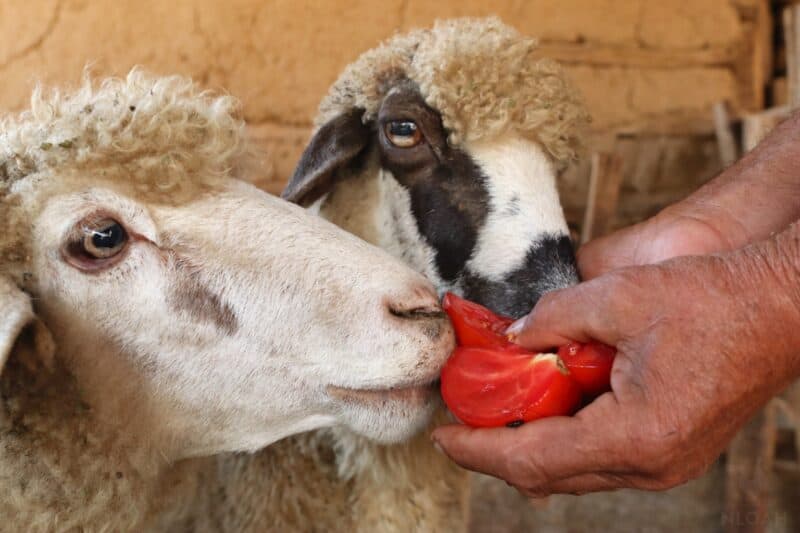
Feeding Sheep
Like cows, sheep are ruminant animals. They eat mostly plants, like grass, hay, and weeds, and don’t need much besides plenty of good grass and a vitamin and mineral supplement. This supplement must include salt as well.
In general, about one acre of pasture can support four to five sheep. This average varies, though, depending on the sheep breed you have and what kinds of plants the pasture contains.
Some breeds, like Icelandic sheep, are better suited to grazing on poor pasture, as they will eat everything (including tree leaves and weeds), while other breeds will only eat high-quality forage.
Be careful about grazing sheep on short pastures. Sheep graze at a much lower level than other grazers, like cattle, who will leave more of the blades exposed above the soil level. Overgrazing can lead to a lot of problems in your flock, including parasitic outbreaks.
In the winter, you will need to supplement your sheep with hay bales or other pasture alternatives, since they won’t be able to access the grass beneath the snow.

If you are supplementing with hay, make sure you use a raised feeder instead of placing it directly on the ground, where it will spoil. For the most part, sheep will not touch soiled or wet hay.
You will also need to provide small quantities of grain, but only in very small quantities. Sheep that are overfed on grain will become fatty and your meat quality will deteriorate.
However, if your ewes are about to lamb, or you are finishing your sheep for market, you will need to provide slightly more protein and calories via a mixture of corn, oats, wheat bran, and linseed meal (which can be found in most commercial grain mixes).
Your sheep also need a vitamin and mineral supplement that is formulated specifically for sheep. Don’t make the mistake of feeding your sheep goat supplement, as this contains high levels of copper. Copper is deadly to sheep.
That being said, the sheep-specific supplement will help support and provide any vitamins that are missing from your sheep’s diet. It will also provide salt, which helps prevent bloating in ruminants. It is best to use a granulated or loose form salt for sheep, instead of a salt block.
Sheep require the following vitamins and minerals:
- Chlorine
- Phosphorus
- Sulfur
- Potassium
- Magnesium
- Calcium
They also require the following in trace amounts:
- Cobalt
- Iodine
- Copper
- Iron
- Manganese
- Zinc
- Molybdenum
- Selenium
Too much grain can cause your sheep to bloat and potentially die. You should overfeed grain and instead provide a little extra supplementation with corn, soy, and oats. Young, lactating, and elderly sheep often require additional feed.
In some cases, supplying your sheep with additional feed can be helpful. For example, if you are trying to train sheep or you want to help them gain weight for market, grain can be a useful tool. Most commercial grain blends also contain beneficial vitamins and minerals that your sheep need.
Your sheep will also need consistent access to a supply of fresh, clean water. You can put out a long trough that many sheep can access at once, but check to make sure the water is filled and clean daily.
Housing and Fencing
Sheep don’t need much in the way of housing or fencing, particularly if they are breeds that are hardier toward inclement weather.
Electric net fencing can be used for temporary paddocks, but keep in mind that sheep can jump, and any low spots in the fence will quickly be compromised. You a also use smooth-wire electric or woven wire non-electric fencing.
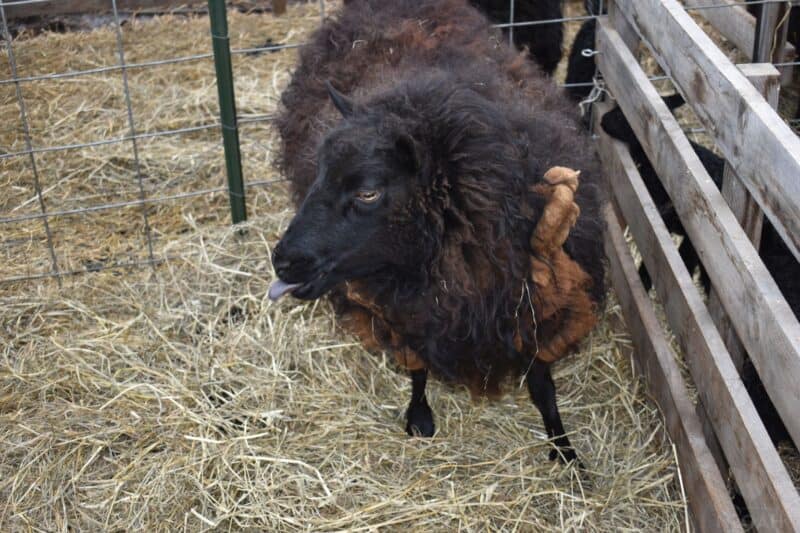
People have mixed feelings about electric fencing. Although they do an excellent job at deterring predators, electric fences have a thick coat of the wool throughout much of the year that help insulate them from shocks. So while an electric fence is very good at keeping things out, it’s not so good at keeping them in.
Furthermore, if you are planning on rotating your sheep into separate paddocks, you may find electric fencing to be a pain.
This is where a net fencing can be helpful, but make sure you are extra vigilant about low spots so that you don’t have a predator or escaped sheep problem on your hands.
Sheep require some shade in the hot months, so make sure there are either some trees in their paddock or that they have some kind of building within which they can get relief from the sun.
In terms of general shelter, a simple, three-sided shed is plenty to protect them from wind, rain, snow, and extreme temperatures. You might consider erecting a portable shed that can be moved as they change paddocks. Sheep need about twenty square feet per animal.
After a labor of about 5 months, when your sheep give birth to lambs, particularly if they are lambing in the winter, you will need some kind of a small, enclosed barn. The young animals are particularly susceptible to the cold, and need to be enclosed during the first few weeks of their lives.
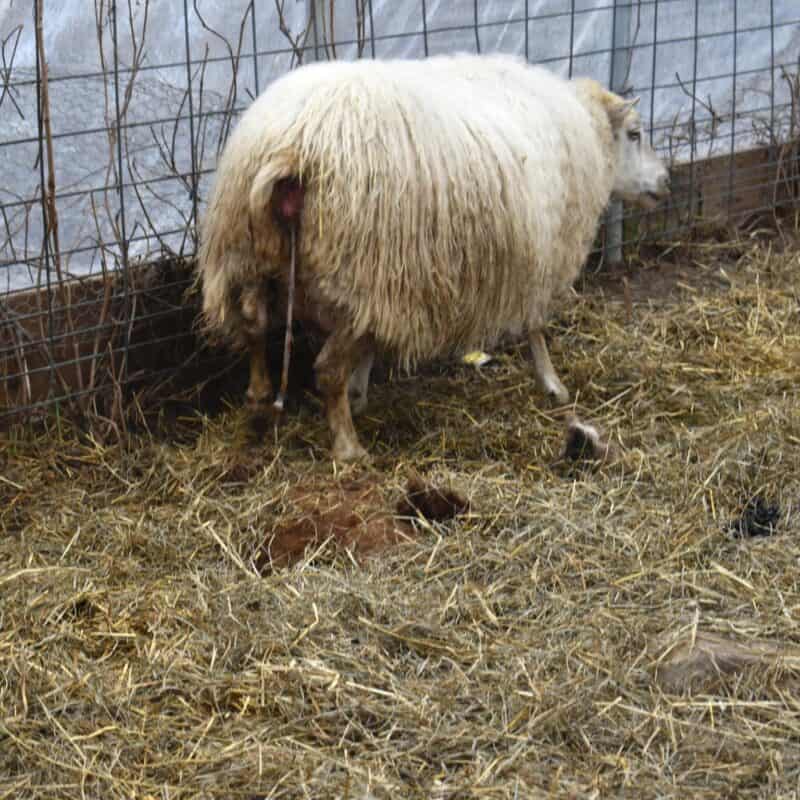
Your sheep may need to be combed and washed regularly, particularly if you are raising them for exhibition or for wool. Keep in mind that you will need an area in which you can do this if you plan on doing either of these tasks.
How to Handle Sheep
Sheep are relatively easy to handle, and to be realistic, you won’t need to handle them very often. If you need to administer medication or medical attention, the best way to do so is through the creation of a handling pen or chute. This will allow you to work with them without causing additional stress by chasing and forcing them down.
There are some other tips you should keep in mind when handling sheep, too. Sheep move with other sheep and will engage in flocking behaviors.
They do not like to be by themselves, and will often move uphill and toward open areas instead of toward buildings or other confined areas. They are easier to herd if they cannot see, so moving them around gentle corners is an easy way to get them to do what you need them to.
Offering food or treats it the best way to train sheep and to reduce their natural fear of you. Grain, apples, or other healthy treats can be used to coax your sheep into coming to you, but avoid chasing them at all costs.
You need to get your sheep to come to you voluntarily. Because of their natural flocking behavior, once you get one sheep to come to you, the rest will instinctually follow.
Caring For Your Flock – Basic Maintenance
Sheep generally have a lifespan of about six to fourteen years. When properly cared for, however, they can live for many years beyond that. Aside from providing year-round shelter (which can even just take the form of a three-sided barn), there are a few other things you will need to keep in mind.
First, a barn with stalls might be helpful if you plan on raising your own lambs. Stalls will allow you to separate pregnant (or simply sick) sheep from the rest of the flock.
You should use straw bedding, particularly during the cold months of the year. Try to avoid pine shavings, as these will cling to the exterior of the sheep’s wool. The same goes for sawdust.
If you’re keeping sheep in a barn, make sure you have a fan to allow for proper ventilation. This is important during the summer months in particular. You might not need the fan during the winter, but you should have an adequately ventilated barn regardless.
You will also need to maintain the hooves of your sheep. If you live in a wet area, this is especially important. Sheep need a dry surface to walk on to prevent foot rot. Occasionally, you will need to cut away excess horn so that the horn doesn’t become infected.
Foot rot is a common issue among sheep, and it’s even more common among sheep who frequently travel on wet ground. Hooves soften and allow bacteria to get in. This can cause lameness and severe pain, and it’s contagious among members of a flock.
When you trim hooves, you’ll need to be areful to get out any dirt and to trim away excess nail that is parallel to the liens of hoof growth. You should trim hooves about once every six weeks, or more often in wet weather.
You may also need to crutch your sheep. This involves trimming the wool around the tail, down the hind legs, and halfway to the belly. This removes built-up urine and feces, preventing the likelihood of flystrike.
Similarly, dagging involves removing dirty wool around the rear and belly of your sheep. Dags are clumps of mud or feces that have become bound into the wool. These can attract blowflies, so it’s important to remove them often.
Finally, you might need to deworm your sheep. Dewormers come in pour-on drench, liquid, paste, bolus, and injectable types.
You might need to rotate among different types of dewormers, like ivermectin and fenbendazole. In many cases, you may be able to use organic alternatives, particularly if you are already practicing good pasture hygiene.
Diseases in Sheep
Sheep tend to be relatively hardy against most diseases, but they are susceptible to parasites. This is especially common when you have sheep living in close confinement.
If you are raising large numbers of sheep in a limited space, rotate the pasture every two or three weeks. You should also apply a deworming treatment every few months to keep parasites at bay.
There are many shots on the market for sheep, but the only one that is universally recommended by veterinarians is CDT.
This shot is administered shortly after your lambs are born (or as an inoculation for the mothers) to help protect against Clostridium perfringens type C +D along with tetanus. Sheep only require one CDT shot over the course of their entire lives.
Some species of sheep may need to have their tails docked, depending on where you live, to protect against fly-blown disease. You could also need to protect them against foot-and-mouth disease, depending on where you live.
Other precautionary behaviors including dipping and giving them shots, but always consult a veterinarian for the best practices in your area so that you are well apprised of how to keep your sheep nice and healthy.
Here are some of the most common diseases in sheep. Most of these can be prevented and treated with basic pasture hygiene and regular maintenance of the flock.
- Cheesy Gland
- Erysipelas arthritis
- Ovine Johne’s Disease
- Scabby Mouth
- Selenium deficiency
- Cobalt deficiency
- Enterotoxaemia
- Tetanus
- Black disease
- Black leg
- Malignant Oedema
- Goitre
- Internal parasites
Parasites are one of the biggest threats to a flock of sheep. As I mentioned, sheep graze grass to a much lower level than other species. They are therefore much more likely to suffer from internal parasites. One of the most malignant is barber pole worm, which can cause severe debilitation and even lead to anemia and eventual death.
Barber pole worms are immune to many chemical dewormers, so it’s important that you practice good preventative care to avoid it and all other parasites on your farm.
Predators
Unfortunately, because sheep are so docile and gentle, it also makes them easy targets for hungry predators. Thousands of sheep are lost every year to coyotes and wolves, while even smaller predators like domestic dogs, birds of prey, and foxes can seriously injure a sheep.
The easiest way to prevent this from happening is to make sure your sheep are in a well-maintained, fenced-in area. Monitor your fences regularly for any damages or downed lines, and consider lining the tops with barbed wire for added protection against jumping predators.
You might also consider maintaining some guard animals, like a trained dog, llama, or donkey that can live within the paddock and help protect your sheep.
Other tips to keep your sheep out of harm’s way include lighting the pens at night, and keeping the sheep in an open field within your range of vision.
This will allow you to keep a better eye on your animals and to prevent problems if and when they should arise. Many people also put bells on their sheep, which can help alert you to a problem if you are nearby.
In general, a well-managed flock within sturdy fencing won’t be threatened by any kinds of predators. Constant monitoring on the part of the shepherd is important, and in most cases, the only predators you will have to worry about are canines.
While small predators like birds of prey can sometimes target newborn lambs, these are less common creatures to have to worry about.
Selling the Meat From Sheep
When you prepare to sell the meat from your sheep to consumers, make sure you are accurately noting the difference between lamb and mutton.
Lamb is meat from a sheep that is less than a year old, while mutton is from an older sheep. Lambs are usually butchered between two and fifteen months of age, while mutton is anything older than this.
If you do intend to sell lamb for meat, make sure you have access to a local market. Lamb and mutton are both unique products that fall into a specific niche, so it’s important that you ensure you have a niche to fill.
In most cases, your meat will need to be processed at a state- or USDA-inspected facility. You may also need to have certain licenses.
Milking
Raising sheep for dairy is a great idea, as sheep milk has more nutritional qualities than cow or goat milk. It’s rich and creamy and is much less likely to irritate those who are lactose intolerant than cow or even goat’s milk is.
Sheep milk can be hard to come by, so if you decide to raise sheep for milk on your farm, you will likely be competing with a very small local market.
Sheep are happy to be out and about in all kinds of weather, but you will definitely want a barn if you plan on milking your sheep. You will need to milk your ewe twice a day.
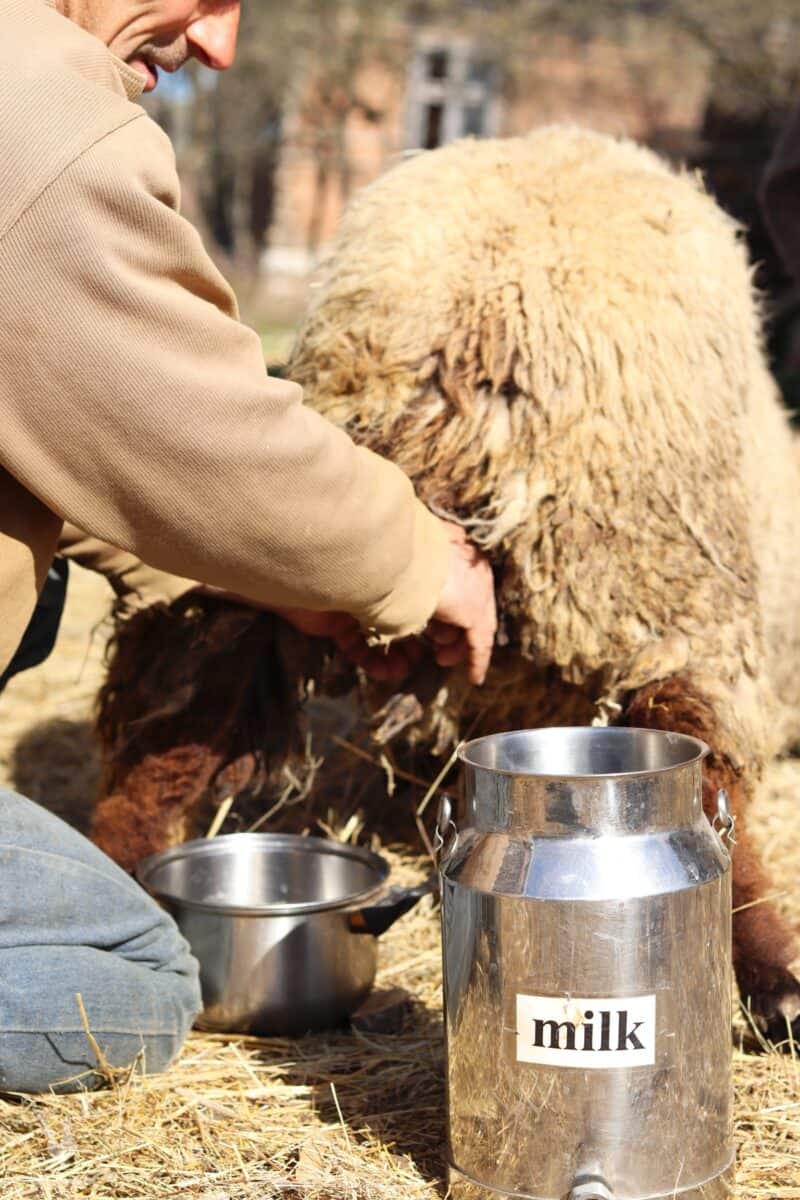
You can hand milk on stanchions or you can use a pit set up if you have quite a few sheep to milk. In this set up, ewes are milked from behind with a pit running behind the sheep.
This is usually done with a milking machine. If you are milking by hand, know that there are several hand techniques and postures you can use to prevent discomfort for the ewe.
Before milking, it’s important that you clean the teats with an udder washing solution. This will clean them of any bacteria that can taint the milk or make your ewe sick.
After milking, you will need to strain and cool the milk. When you are storing the milk, you should do so in stainless steel containers, as they will be much easier to sanitize.
Shearing Sheep
About once or twice a year, you will need to harvest your sheep’s wool. Some longer-wooled breeds will need to be sheared even more often.
Wool can be sold to a wool pool, which then markets it directly to a warehouse or wool mill, or to a private warehouse. There are also fiber cooperatives and similar networks you can explore for selling wool.
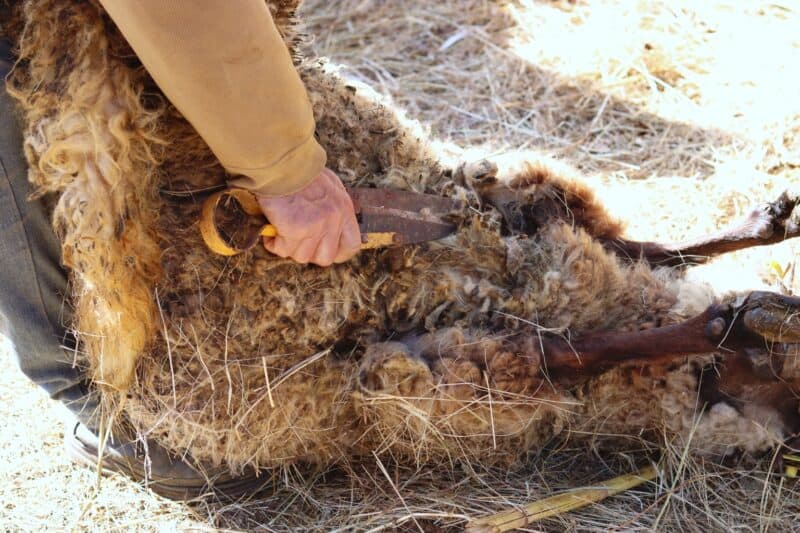
Regardless of how often you shear your sheep, you should try to shear your sheep as early in the spring and as early in the fall as possible. Ideally, you should do this before lambing and always on a clean, dry surface.
In the fall, you need to shear early enough so that your sheep have time to put on fresh wool before colder temperatures arrive.
After you shear, you will need to either find a market for raw wool or you will need to clean and card it yourself. Regardless of whether you card and spin your own wool, you should remove any undesirable parts of fleece, like stains and sweat locks.
Shearing is difficult work, and requires skill so that the sheep are shorn short enough without injuries o the sheep. It can be stressful to the sheep if you do not shear it properly. Most people use electric shearers to shear their sheep.
Always pen your sheep prior to shearing time. Separate them out into lambs, yearlings, rams, and ewes, and always fast them before shearing to avoid contaminating the shearing floor.
Your sheep should be clean and dry for best results. It usually takes a few minutes to shear a sheep, with professional sheep shearers doing so in under a minute. If you are nervous about shearing your own sheep, or want the best results, consider hiring a professional.
Selling Wool from Sheep
Wool can comprise a large amount of your sheep-based income, depending on where and when you sell it.
Wool can be sold to a wool pool, which then markets it directly to a warehouse or wool mill, or to a private warehouse. There are also fiber cooperatives and similar networks you can explore for selling wool.
Breeding Sheep
If you are planning on breeding your sheep, make sure you provide them to access to adequate shelter that is free of drafts. Lambs born in cold temperatures are more susceptible to hypothermia.
Consider whether you want to risk early lambing in order to save on labor costs, requiring an early spring or late winter birth, or whether you are willing to wait to lamb until April or May, when the weather will be warmer.
Select your breeding stock carefully, particularly in regard to the ram. He is arguably the most important member of the flock, since his genetics will likely be spread more widely over your flock.
Rams reach puberty between five and seven months of age. An ewe in heat will usually seek out the ram, courting him by sniffing and chasing after him.
The ram will respond by curling his lip, at which point the female will stand for mating. Rams will usually select older ewes over younger ewes, and may breed the same ewe several times if he senses that she has not become pregnant and she has gone back into heat.
There is usually no need for the shepherd to get involved in this process at all – the rams and ewes know instinctually for the most part when successful breeding has taken place.
If you’re concerned about when and if your ewes have been bred, you may consider investing in a marking harness for your ram – just be aware that these present their own risks (such as the potential for the ram to catch himself on a fence or tree limb).
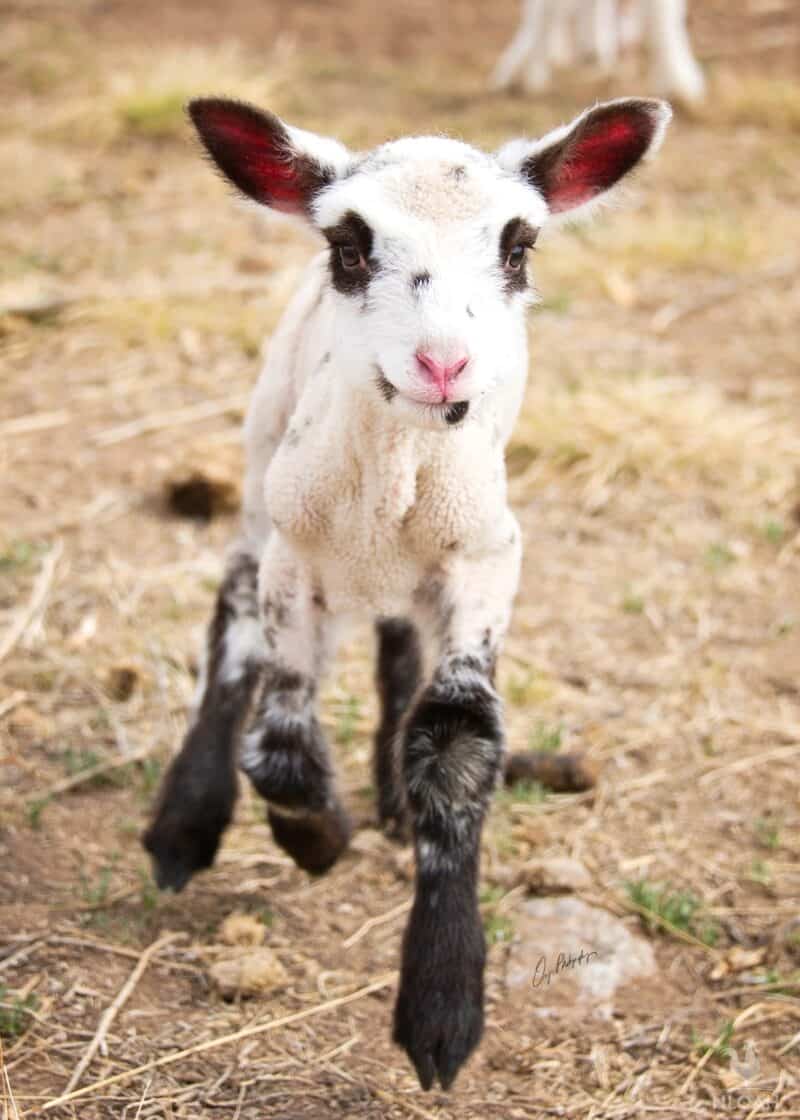
Ewes are generally able to deliver their own lambs without any need for intervention. When your ewe is ready to give birth, you should be prepared to keep a distance, but to lend a helping hand as needed.
Keep an eye out for signs that your ewe is ready to give birth, like a dilated vulva and a lack of appetite. The entire process takes about twenty-four to thirty-six hours to complete.
It’s important that you keep a close eye on your mother ewes and lambs shortly after birth. About twenty percent of lambs die before they are weaned, with most of those losses occurring within the first ten days.
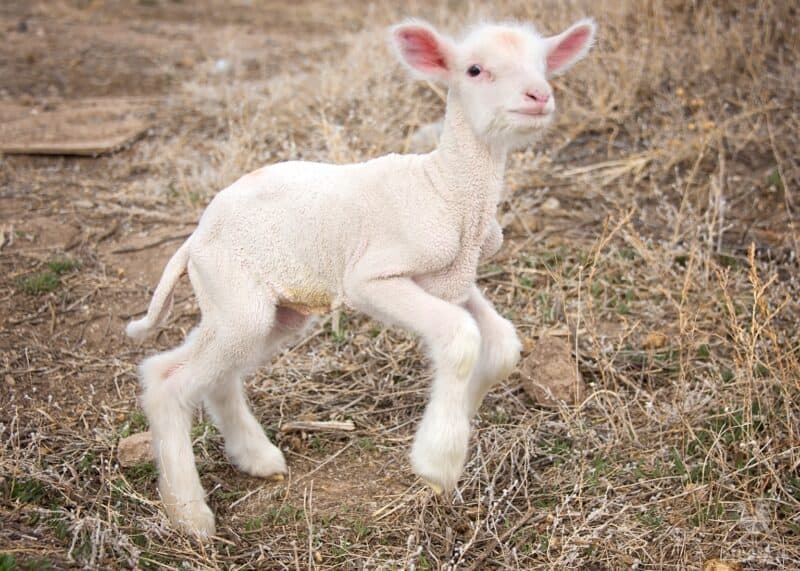
Monitor your lambs, and make sure that they are nursing. This is particularly important within the first twenty-four hours after birth, since the lambs need to take in the colostrum, or “first milk,” from their mothers. This helps build their immune systems.
Lambs are typically weaned at about two months. Shortly after birth, the lamb will begin to nibble on food, and the ewe will dry up within about eight weeks.
If you decide to try to wean your lambs before they have done it on their own, you can easily do this by separating ewes from lambs.
Lambs should be placed on solid feed at least two weeks before this – and they should also be accustomed to drinking water. This will prevent any undue stress before you move your lambs.
Is Raising Sheep for You?
If you have enough space for the sheep you want to raise, and the right reasons for doing so, you should definitely consider raising sheep.
Particularly if you have long wanted to add a herbivore species to your homestead, but are unwilling to take the major leap to cattle, sheep are a good transition species.
Sheep provide a number of benefits, allowing you to earn a living from their wool, hides, milk, meat, and even their ability to keep vegetation down.
While there are some financial considerations to make when you are starting out with sheep (such as the cost of fencing, vaccinations, and of course, the sheep themselves), keep in mind that they are one of the lowest cost and most enjoyable animals you can raise.
Frequently Asked Questions
It can be tough to raise sheep and make a profit – particularly if you are new to the endeavor. However, if you have productive sheep that are well-suited to your environment and keep close track of your expenses, you can easily produce income even on a small amount of acreage.
The best advice to make a profit raising sheep is to choose breeds that are triple-purpose or at least dual-purpose and to take advantage of every local market you might have.
In addition, you can keep costs down by performing as much flock maintenance as possible by yourself, such as shearing, lambing, and trimming hooves.
This varies depending on the type of pasture you have available to your sheep, as well as if you have pre-existing structures for fencing and housing.
The cost of the sheep alone will range between $175 and $450 per productive ewe, and they’ll cost roughly $50 apiece each year to raise – that’s an absolute minimum.
This is why it’s so important to keep close track of your expenses and to pare them down as much as possible.
Of course, raising sheep is an economy of scale – the more sheep you have, the more likely you are to make a profit and the less expensive per head it’s going to be to raise them.
Sheep prefer fine, leafy hay. In most cases, they will not eat coarse hay. The best options are leafy alfalfa and immature grass hay.
Lambs do best with legume-harvested (which has finer stems) while mature sheep can survive on high-quality grass hay. Ideally, you should look for higher protein hay but adult sheep that are not breeding can do just fine on a nice second cutting grass hay.
Do you have patience? A little bit of practical know-how? If so, you can easily raise sheep. However, know that you will need to provide some care beyond the level of care required to raise basic livestock like chickens.
Sheep may be easier to manage than cattle or other more challenging (or simply larger) livestock, but you still need to be on top of things in order to raise a healthy and productive flock.
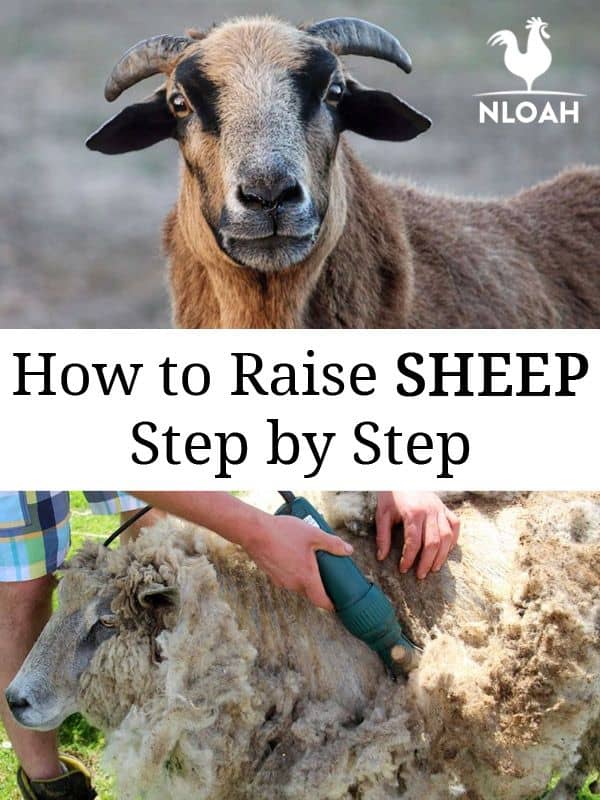

Rebekah is a high-school English teacher n New York, where she lives on a 22 acre homestead. She raises and grows chickens, bees, and veggies such as zucchini (among other things).
